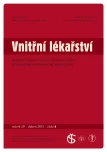The benefits of a remote monitoring system in long‑term follow up of patients with implantable cardioverter‑ defibrillators
Authors:
O. Ošmera 1; A. Bulava 1,2
Authors‘ workplace:
Kardiologické oddělení Nemocnice České Budějovice, a. s., přednosta prim. MU Dr. František Toušek, FESC
1; Zdravotně sociální fakulta Jihočeské univerzity České Budějovice, děkanka prof. PhDr. Valérie Tóthová, Ph. D.
2
Published in:
Vnitř Lék 2013; 59(4): 269-276
Category:
Original Contributions
Overview
Introduction:
An increasing number of patients with implantable devices in cardiology raises the need for better and more efficient outpatient follow‑up. Telemonitoring (remote monitoring) can be widely used as an important part of care for the patient and the device itself due to the technological progress in communication and transmission systems and implantable devices themselves.
Objectives:
To evaluate the benefits of continuous remote monitoring system using Home Monitoring (HM)TM (BIOTRONIK) compared with standard outpatient controls.
Patients and methods:
198 patients (67 ± 12 years, 80.8 % men) who have been implanted a single‑chamber or dual- chamber implantable cardioverter‑ defibrillator (ICD) (163/ 35) in 2008– 2009 in the primary or secondary prevention (75/ 123) of sudden cardiac death were followed prospectively. Planned and emergency visits, hospitalization for events related to ICD, delivered shock therapies and their adequacy were evaluated in a group of patients followed in a standard way of outpatient visits (HM– ) and a group telemonitored by HM system (HM+).
Results:
A significant reduction was achieved in the number of planned (48 %) and total controls (45 %) during a three‑years follow up. There was a comparable number of patients who experienced one or more shock therapy (only with a trend to a lower number of patients who obtained a shock in HM+ group, p = 0.25), and there was equivalent mortality of both groups and the number of patients hospitalized in relation to ICD. However there was a success in significant reduction in the number and proportion of inadequate shocks delivered in HM+ patient group by 80 % in ambulatory follow up and by 90 % including multiple shocks, which required a hospitalization.
Conclusion:
The HM system demonstrates an effective and safe way of ICD patients follow‑up which helps to reduce the number of outpatient visits and inadequate shock therapies in long‑term monitoring.
Key words:
remote monitoring – Home Monitoring – implantable cardioverter‑ defibrillator
Sources
1. Eucomed http:/ / www.eucomed.org/ uploads / _medical_technology/ facts_figures/ 110518_statistics_for_ cardiac_rhythm_management_products_20052010.pdf
2. Ricci RP, Morichelli L, Santini M. Home monitoring remote control of pacemaker and implantable cardioverter defibrillator patients in clinical practice: impact on medical management and health– care resource utilization. Europace 2008; 10: 164– 170.
3. Wilkoff B, Auricchio A, Brugada J et al. HRS/ EHRA expert consensus on the monitoring of cardiovascular implantable electronic devices (CIEDs): description of techniques, indications, personnel, frequency and ethical considerations. Europace 2008; 10: 707– 725.
4. Lazarus A. Remote, wireless, ambulatory monitoring of implantable pacemakers, cardioverter defibrillators, and cardiac resynchronization therapy systems: analysis of a worldwide database. Pacing Clin Electrophysiol 2007; 30: (Suppl. 1): S2– S12. Erratum in: Pacing Clin Electrophysiol 2007; 30: 1424.
5. Nielsen JC, Kottkamp H, Zabel M et al. Automatic home monitoring of implantable cardioverter defibrillators. Europace 2008; 10: 729– 735.
6. Národní registr implantabilních defibrilátorů Pracovní skupiny pro arytmie a kardiostimulaci České kardiologické společnosti (PS AKS ČKS) – prezentováno 29. 1. 2012 na X. českém a slovenském sympóziu o arytmiích a kardiostimulaci ve Zlíně.
7. Dubner S, Auricchio A, Steinberg JS et al. ISHNE/ EHRA expert consensus on remote monitoring of cardiovascular implantable electronic devices (CIEDs). Europace 2012; 14: 278– 293.
8. Varma N, Epstein A, Schweikert R et al. Evaluation of efficacy and safety of remote monitoring for ICD follow‑up: the TRUST trial, Circulation 2008; 118: 2316, Abstract 4078.
9. Ricci RP, Morichelli L, Santini M. Remote control of implanted devices trough Home Monitoring technology improves detection and clinical management of atrial fibrillation. Europace 2009; 11: 54– 61.
10. Varma N, Epstein A, Irimpen A et al. The lumos- T safely reduces routine efficacy and safety of automatic remote monitoring for implantablecardioverter‑ defibrillator follow‑up. The Lumos- T Safely Reduces Routine Office Device Follow‑Up (TRUST) Trial. Circulation 2010; 122: 325– 332.
11. Theuns DA, Klootwijk AP, Simoons ML et al. Clinical variables predicting inappropriate use of implantable cardioverter‑ defibrillator in patients with coronary heart disease or nonischemic dilated cardiomyopathy. Am J Cardiol 2009; 95: 271– 274.
12. Fauchier L, Sadoul N, Kouakam C et al. Potential cost savings by telemedicine– assisted long‑term care of implantable cardioverter defibrillator recipients. Pacing Clin Electrophysiol 2005; 28: (Suppl. 1): S255– S259.
13. Res JC, Theuns DA, Jordaens L. The role of remote monitoring in the reduction of inappropriate implantable cardioverter defibrillator therapies. Clin Res Cardiol 2006; 95: (Suppl. 3): III17– III21.
14. Ošmera O, Bulava A. Přínos systému telemonitoringu v dlouhodobém sledování pacientů s ICD. IX. slovenské a české sympózium o arytmiách a kardiostimulácii. Abstrakt Cardiology Lett 2011; 20: 75– 92.
15. Mabo P, Victor F, Bazin P et al. A randomized trial of long‑term remote monitoring of pacemaker recipients (The COMPAS trial). European Heart Journal 2012; 33: 1105– 1111.
16. Kacet S et al. Safety and Effectiveness of ICD Follow‑up using Remote Monitoring: ECOST Study. Presented in Hot Line Session at ESC 2011 Congress. http:/ / spo.escardio.org/ eslides/ view.aspx?eevtid=48&fp=2175
Labels
Diabetology Endocrinology Internal medicineArticle was published in
Internal Medicine

2013 Issue 4
Most read in this issue
- Aortic stenosis
- Lung metastases as the first manifestations of occult medullary microcarcinoma
- The „Short Physical Performance Battery“ in the Czech Republic – the pilot and validation study in older persons
- Perindopril in the treatment of hypertension and cardiovascular diseases: evolution continues with the orodispersible dosage form
